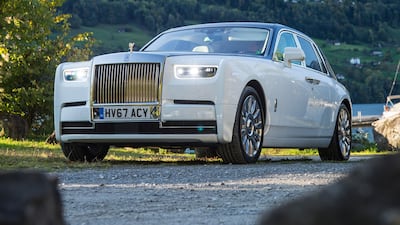If there were such a thing as automotive royalty, the Rolls-Royce Phantom would be it. After all, what other single nameplate can claim a heritage that dates back 92 years? Apart from two breaks in continuity – from 1940-1950 and 1991-2003 – the Phantom has been the flag bearer for the Rolls line-up and served as the default limo for heads of state, dignitaries and aristocracy.
The big Roller has managed to stay relevant in a world that is obviously much different now than when the first-gen Phantom debuted in 1925. As a company, Rolls-Royce has weathered its fair share of storms over the past century – including bankruptcy in 1971 – and the brand stood at the crossroads in the early noughties, lumbered with a model range that owed its ancient underpinnings to cars designed in the 1960s.
The fact that Rolls-Royce not only exists but prospers today (it sold 4,011 cars last year; its second-highest tally in its 113-year history) is down to a BMW Group takeover of the company in 1998. The notion of a German carmaker taking the reins of a British automotive icon would have horrified purists, but the wholesale makeover of the brand that BMW subsequently rolled out proved to be a masterstroke (unlike the Bavarians' stewardship of Rover and Land Rover).
BMW had to start from scratch, because after establishing the born-again Rolls-Royce company, it had to find a fresh location, build a new factory and head office, and design a brand-new car. The vehicle was subsequently developed in complete secrecy and the people working for the company were sworn to silence. Rolls-Royce Motors Cars Limited was established at the start of 2003, and the state-of-the-art, seventh-generation Phantom debuted later that year.
Unlike the antiquated vehicles that preceded it, the Phantom VII was a techno tour de force, underpinned by a sophisticated and lightweight aluminium space-frame chassis, powered by a new 460hp, 6.75-litre V12, and loaded with all the electronics and mod-cons on offer in 2003.
This was the car to kick Rolls-Royce into the new millennium, dispensing with all the olde-worlde frumpiness of its forerunners in one fell swoop, yet still embodying all the stateliness and gravitas that is such an integral part of the RR brand. In the process, not only did it find favour with traditional Rolls-Royce customers, but also succeeded in attracting new, more tech-savvy buyers to the marque.
But time marches on, and while the Phantom VII has soldiered on nobly for the past 14 years, about double the typical lifespan of a luxury car, the time was ripe for an all-new successor that caters to the Rolls-Royce customer of 2018 and beyond. The average age of today's RR buyer is now said to be 39, about 20 years younger than used to be the case a couple of decades ago.
This being so, Rolls-Royce sought to infuse a greater sense of dynamism and "movement" into the Phantom. Whereas the outgoing model was a cutting-edge design when it was penned, its profile is very upright, and too "static". So they addressed this by integrating the grille into the bodywork and leaning it back a few degrees (it formerly stood clear of the bodywork and sat bolt upright). The tapered flanks of the car also create the impression of motion, and the fastback roofline further contributes to this effect.
_______________________
Read more:
The all-new Rolls-Royce Phantom - in pictures
The decoder: Rolls-Royce's Spirit of Ecstasy
The Arabian Gazelles: Meet the UAE's first women-only luxury and supercar club
Latest from The National's Motoring section
_______________________
Underpinning it all is a new, 30 per cent stiffer aluminium space-frame architecture, and this ultra-flexible platform will form the basis for all of RR's upcoming models, including the keenly anticipated SUV – due next year – known for now as "Project Cullinan". Propulsion for the Phantom VIII comes from a 6.75-litre V12 that now features twin-turbocharging, boosting outputs to an unflustered 570hp and 900Nm to ensure the Roller offers the "waftability" synonymous with the brand.
The Phantom packs a veritable techno arsenal, including a pair of cameras that scan the road ahead and pre-emptively prepare the suspension for upcoming surface irregularities. Each corner of the car is suspended on four-litre airbags for a "magic-carpet" ride, and even the massive tyres are foam-filled to further cushion the ride. Occupants are insulated from the outside world by double-glazed windows (two 3-millimetre-thick panes sandwich an acoustic layer), and there is no less than 130 kilograms of sound-deadening material layered around the cabin.
Naturally, there are lashings of the finest hand-crafted leather and walnut trim (all made to bespoke order), and a day-long drive across Swiss alpine roads provides proof that the Roller still stands as the king of the hill when it comes to cosseting its occupants. No other car is this whisper-quiet or feather-soft in its ride – and you would expect as much, given the Phantom's starting price of Dh1.95 million (or Dh2.2m for the Extended Wheelbase).
RR spokesman Richard Carter is on the money when he says: “There’s not one person in the world who needs a Rolls-Royce Phantom.” Those who buy it do so because it remains the ultimate motorised statement of power and prestige. It is art on wheels.

